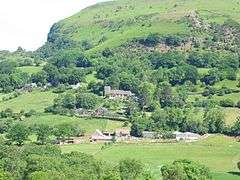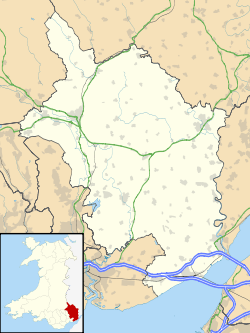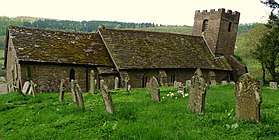Cwmyoy
Cwmyoy is an extensive rural parish in Monmouthshire, Wales (Welsh: Cwm Iou) for the valley and parish, (Welsh: Cwm-iou) for the village. The standard Welsh name is Cwm Iau / Cwm-iau. In the Gwentian dialect of Welsh that was spoken here until the late 1800s, the name was pronounced as Cwm Iou ('ou', also spelt informally 'oi', for standard 'au' is a common feature of south Wales Welsh). The 'English' name is in fact this local dialect form in a more English spelling. The name of the valley probably originates from the Welsh word 'iau' meaning yoke, in reference to the shape of the hill surrounding it.[1]
Cwmyoy
| |
|---|---|
 Cwmyoy, on the slope of Hatterrall Hill | |
 Cwmyoy Location within Monmouthshire | |
| OS grid reference | SO299232 |
| Principal area | |
| Ceremonial county | |
| Country | Wales |
| Sovereign state | United Kingdom |
| Post town | ABERGAVENNY |
| Postcode district | NP7 |
| Dialling code | 01600 |
| Police | Gwent |
| Fire | South Wales |
| Ambulance | Welsh |
| UK Parliament | |
The village of Cwmyoy is located 7 miles north of Abergavenny and 4 miles south of Llanthony in the Vale of Ewyas in the Black Mountains. It is within the Brecon Beacons National Park, in an upland location just below the broad ridge of Hatterrall Hill, which carries the Wales-England border along which runs Offa's Dyke Path.
The parish
The parish is nearly 8 miles long and 1 mile broad, and includes Llanthony as well as Cwmyoy itself. In 1893, an area in the neighbouring valley of the Grwyne Fawr, known in Welsh as Ffwddog and in English as the Fothock, which had been an exclave of Herefordshire, was transferred into the parish.[2]
Local amenities
The Cwmyoy area is very popular for hillwalking and pony trekking. Llanthony Priory, Capel-y-ffin and Gospel Pass are all accessed by passing below Cwmyoy village.
Cwmyoy also has a small village hall which is run as a registered charity.[3]
St Martin's Church

Cwmyoy is best known for St Martin's Church which has been called the "most crooked church in Great Britain."[4] St Martin's Church is a stone parish church standing on a steep hillside on the east side of the valley and subject to slippage. The church chancel has been described as a remarkable example of a "weeping chancel", where the nave represents Christ's body and the deflected chancel his head fallen sideways in death. At Cwmyoy not only the axis but the whole chancel slews sideways. Hando calls it "the Church below the Landslide".[5]
References
- Owen, H.W. & Morgan, R. 2007 Dictionary of the Place-names of Wales Gomer Press, Llandyssul
- Kelly's Directory of Monmouthshire, 1901
- "Cwmyoy Memorial Hall". OpenCharities. 13 June 2015. Retrieved 20 October 2015.
- "Toronto SUN". M.torontosun.com. 19 October 2011. Archived from the original on 19 September 2016. Retrieved 12 February 2012.
- Hando, F.J., (1958) "Out and About in Monmouthshire", R. H. Johns, Newport.
External links
| Wikimedia Commons has media related to Cwmyoy. |